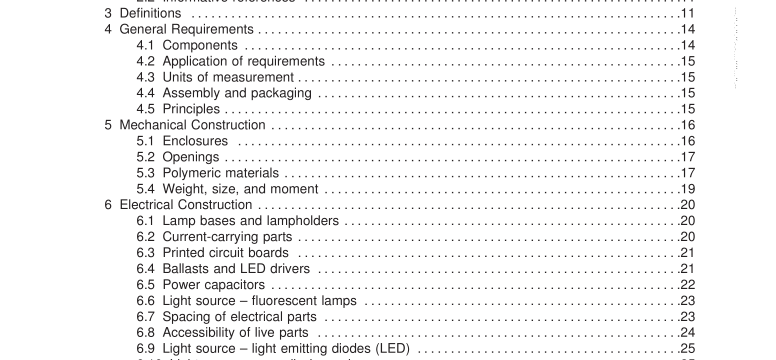UL 1993-2009 pdf download.Self-Ballasted Lamps and Lamp Adapters.
3.2 DEVICE – a self-ballasted lamp or lamp adapter. The specific name is used when it applies to only one of the devices. 3.3 DEVICE BASE – a screw-base or other ANSI base that connects the device to a mating lampholder for outlet boxes or to lampholders provided in luminaires, portable luminaires, or signs. 3.4 DEVICE LAMPHOLDER – a lampholder provided for the replaceable light source. 3.5 DEVICE LAMPHOLDER KEYING – a lampholder design that can accommodate only matching lamp bases. 3.6 ELECTRONIC BALLAST – a ballast, generally involving high-frequency switching that is controlled by active components (transistors, thyristors, and the like), and with the lamp ballasting impedance provided by a series capacitive or inductive reactance appropriate for the high switching frequency. “Ballast” also refers to other drivers or supplies that operate lamp technologies other than fluorescent. 3.7 ENCLOSURE – a material provided to enclose parts and components that can involve the risk of fire or shock hazard. 3.8 LAMP ADAPTER – a self-ballasted lamp with a replaceable light source. 3.9 LAMP CONNECTOR – a set of contacts attached to flexible conductors that provides a removable means for electrical connection to a lamp but does not provide mechanical support. 3.1 0 LAMP, SELF-BALLASTED – a device provided with a lamp base and incorporating a non- replaceable light source and any additional elements necessary for starting and stabilizing operation of the light source, which cannot be dismantled without being permanently damaged. 3.1 1 LIVE PART – a metal or other conductive part that, during intended use, has an electrical potential difference with respect to earth ground or any other conductive part. The grounded (or neutral) supply conductor is considered to be a live part.
3.1 6 LUMINAIRE, RECESSED – a luminaire that is designed to be either wholly or partially recessed in a mounting surface. 3.1 7 POWER CAPACITOR – a capacitor used with a magnetic ballast that is connected: a) In series with a lamp or lamps and provides the ballast impedance for the lamp current, or b) For power-factor correction across the input leads of the ballast or across an extension of the primary winding. 3.1 8 SUPPLY LAMPHOLDER – a lampholder of a luminaire or portable luminaire or sign that can accommodate and supply power to a self-ballasted lamp or lamp adapter. 3.1 9 TYPE TEST – testing of a representative sample of the device with the objective of determining if the device, as designed and manufactured, can meet the requirements of this standard. 4 General Requirements 4.1 Components 4.1 .1 Except as indicated in Clause 4.1 .2, a component of a product covered by this standard shall comply with the requirements for that component. See Annex A for a list of standards covering components generally used in the products covered by this standard. A component shall comply with the ANCE, CSA, or UL standards as appropriate for the country where the product is to be used. In Mexico, the requirements of Clause 4.1 do not apply. 4.1 .2 A component is not required to comply with a specific requirement that: a) Involves a feature or characteristic not required in the application of the component in the product covered by this standard, or b) Is superseded by a requirement in this standard. 4.1 .3 A component shall be used in accordance with its rating established for the intended conditions of use. 4.1 .4 Specific components are incomplete in construction features or restricted in performance capabilities. Such components are intended for use only under limited conditions, such as certain temperatures not exceeding specified limits, and shall be used only under those specific conditions.
4.5.1 .2 Risk of electric shock is usually defined only in terms of electrical voltage, current, and frequency. Throughout this standard, voltage between parts greater than 30 V rms , 42.4 V peak (and DC) – half of these limits for wet locations – is considered to be a risk of electric shock. When the current available is greater than 0.5 mA rms for perception and greater than 5.0 mA rms for let-go, for direct current and alternating current up to 1 kHz, the current is considered to be a risk of electric shock. A passive network connected across the meter input terminals of a measuring instrument compensates for the pathway body impedance and frequency. The test method and meter network are described in UL 1 01 . 4.5.2 Risk of fire 4.5.2.1 The risk of fire can occur when electrical energy is converted to heat, and the heat is entrapped. It is difficult to define the energy level in terms of electrical parameters alone because the degree of entrapped heat will determine whether or not there would be combustion. In addition, risk of fire can be abated by a suitable enclosure (fire can be confined by the enclosure). 4.5.2.2 There are several possible indicators that are used while conducting a given test. Throughout this standard, the check for fire hazard is either by a specific temperature limit or a change of an indicator. For example, one fire indicator is a layer of cheesecloth, and its change of state occurs when it ignites and causes combustion. 4.5.2.3 Throughout this standard, an energy level of 1 5 VA is considered to be a sufficient level to support a fire. A circuit having 1 5 VA available is considered to be a fire-hazardous circuit. 4.5.2.4 Throughout this standard, a suitable enclosure is described in Clauses 5.1 and 5.3.UL 1993-2009 pdf download.
UL 1993-2009 pdf download
